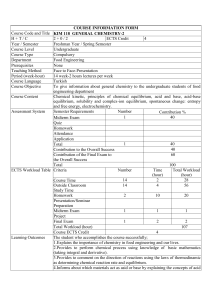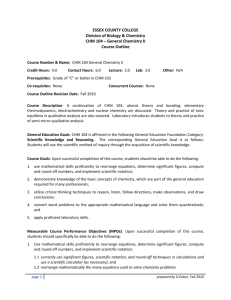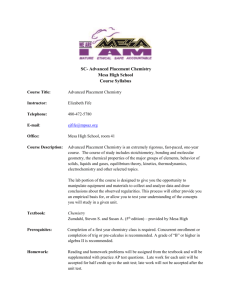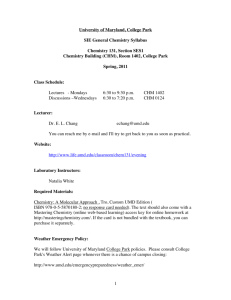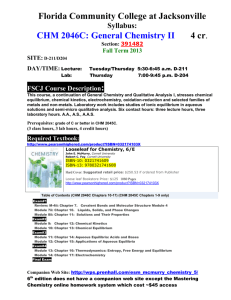general chemistry - Purdue University Calumet
advertisement
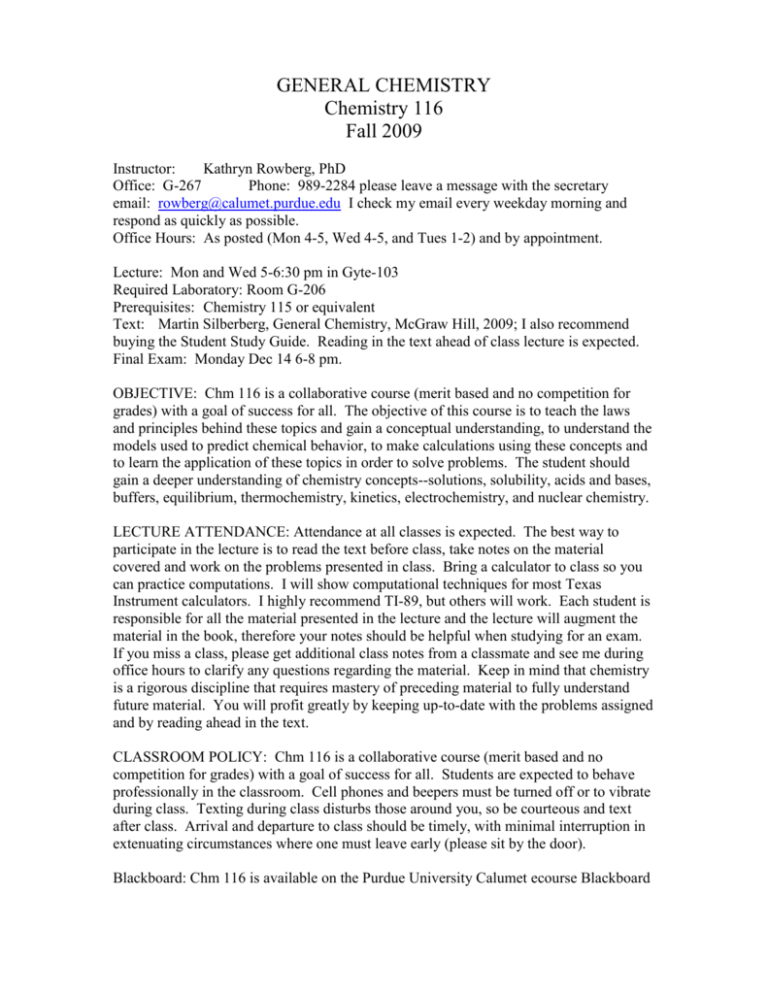
GENERAL CHEMISTRY Chemistry 116 Fall 2009 Instructor: Kathryn Rowberg, PhD Office: G-267 Phone: 989-2284 please leave a message with the secretary email: rowberg@calumet.purdue.edu I check my email every weekday morning and respond as quickly as possible. Office Hours: As posted (Mon 4-5, Wed 4-5, and Tues 1-2) and by appointment. Lecture: Mon and Wed 5-6:30 pm in Gyte-103 Required Laboratory: Room G-206 Prerequisites: Chemistry 115 or equivalent Text: Martin Silberberg, General Chemistry, McGraw Hill, 2009; I also recommend buying the Student Study Guide. Reading in the text ahead of class lecture is expected. Final Exam: Monday Dec 14 6-8 pm. OBJECTIVE: Chm 116 is a collaborative course (merit based and no competition for grades) with a goal of success for all. The objective of this course is to teach the laws and principles behind these topics and gain a conceptual understanding, to understand the models used to predict chemical behavior, to make calculations using these concepts and to learn the application of these topics in order to solve problems. The student should gain a deeper understanding of chemistry concepts--solutions, solubility, acids and bases, buffers, equilibrium, thermochemistry, kinetics, electrochemistry, and nuclear chemistry. LECTURE ATTENDANCE: Attendance at all classes is expected. The best way to participate in the lecture is to read the text before class, take notes on the material covered and work on the problems presented in class. Bring a calculator to class so you can practice computations. I will show computational techniques for most Texas Instrument calculators. I highly recommend TI-89, but others will work. Each student is responsible for all the material presented in the lecture and the lecture will augment the material in the book, therefore your notes should be helpful when studying for an exam. If you miss a class, please get additional class notes from a classmate and see me during office hours to clarify any questions regarding the material. Keep in mind that chemistry is a rigorous discipline that requires mastery of preceding material to fully understand future material. You will profit greatly by keeping up-to-date with the problems assigned and by reading ahead in the text. CLASSROOM POLICY: Chm 116 is a collaborative course (merit based and no competition for grades) with a goal of success for all. Students are expected to behave professionally in the classroom. Cell phones and beepers must be turned off or to vibrate during class. Texting during class disturbs those around you, so be courteous and text after class. Arrival and departure to class should be timely, with minimal interruption in extenuating circumstances where one must leave early (please sit by the door). Blackboard: Chm 116 is available on the Purdue University Calumet ecourse Blackboard site. To access the site, go to the Purdue University Calumet homepage and click on ecourses. Enter into Chm 116 and choose from the available menu the information you want. There will be copies of the syllabus, samples of exams from previous years, handouts from class, copies of overheads used in class, announcements from class, etc. Although email options are available, I can’t reply to email sent through Blackboard. Please use your Purdue email and always include your section number. My email address is at the top of the syllabus. I usually check my PUC email daily except during weekends and breaks. GRADING AND EXAMINATIONS: Scores from the top four of five quizzes (20 points each), scores from 10 of 11 lab periods (20 points/week of lab time), homework (complete the chapter questions for 10 pts credit), three exams (100 pts each), and the final cumulative exam (150 pts) will be used to calculate your grade. Lecture quizzes will be given at the beginning of class and usually announced one week in advance. There are no makeup quizzes, but the lowest lecture quiz score will be dropped. The lowest lab score (of the 20-point labs) will be dropped. This allows for an unforeseen absence that will not count against you. Only students given permission in advance by the instructor and those with excused absences will be permitted to take a make-up exam. More than two unexcused absences from the lab is reason to initiate administrative withdrawal of the student. Homework is to be completed and submitted in class. Homework will have a due date and there will be a 2-point penalty for each day late. All homework problems will be collected but only three will be graded per chapter. The answers to homework problems will be available after the homework has been graded. Exams are graded carefully. If you wish to have your exam regraded, write the problem number at the top front of the exam and the reason for regrading. All students are held accountable to the Honor Pledge. Any academic dishonesty will be dealt with according to University Policy (see handbook). Giving or receiving unauthorized aid is strictly forbidden. When doubt exists concerning aid, ask if it is permitted. For example, doing homework problems in a group is not only allowed, but encouraged. Furthermore, notes are not allowed in quizzes, although you may ask the instructor questions during the quiz. Any act of dishonesty during a quiz, exam, or in the lab will be penalized at the discretion of the instructor. Special lecture events and extra credit assignments will be mentioned in class. Students will receive 5 extra credit points for each completed assignment for a maximum of 10 points. The exam dates have been set and are in this syllabus. Please note them and transfer them to your calendar. CHM 116 Tutoring: Individual and group help is available at the Center for Student Achievement (Gyte-100). See their schedule for available tutors. Supplemental Instruction: Supplementary Instruction is available and highly recommended. Students find that these sessions give greater confidence over mastery of the material. EMERGENCY PROCEDURES: In case of emergency, please notify campus police as soon as possible (989-2911). Be aware of emergency exits in the classrooms and familiarize yourself with the evacuation plan posted in each room. Please discuss safety concerns with the instructors. An Emergency Printout is available from the instructor. SPECIAL ASSISTANCE: If you are a student with a documented disability who will require academic/classroom accommodations in this course, please register with the Coordinator of Services for Students with Disabilities in the Student Support Services Office located in the Student Union and Library Building (SUL), Room 341, phone numbers: 219-989-2455, 219-989-2454(voice/TTY) or 219-989-2920. Contact with Professor: Please feel free to drop by my office and talk about the course, chemistry questions, career ideas, summer jobs, etc. I would like to foster student participation in science activities and I want to be a resource to you in achieving your goals. Remember Chm 116 is a collaborative course (merit based and no competition for grades) with a goal of success for all. COURSE POINT DISTRIBUTION: Quizzes 80 Homework 90 Labs 200 Exams I, II and III 300 Final 150 Total 820 pts The assignment of grades will be based on total percentage of points earned. The scale representing the percentage of points needed is below. A 85% B 75% C 65% D 50% Keep your personal record of points. Quiz ___ ___ ___ ___ ___ ___ ___ Homework ___ ___ ___ ___ ___ ___ ___ ___ ___ Exams ___ ___ ___ Lab ___ ___ ___ ___ ___ ___ ___ ___ ___ ___ Final ___ Extra Credit ___ ___ ___/80 (drop lowest) ___/90 ___/300 ___/200 (drop lowest) ___/150 ___ Total _______/820 COURSE OUTLINE: Aug 31,Sept 2 Ch 12.1-12.6 Intermolecular Forces Sept 9,14,16 Ch 13.1-13.7 Properties of Mixtures Exam I Sept 21 Chapters 12,13 Sept 23,28,30 Oct 5,7 Oct 12,14,19 Ch 16 Kinetics Ch 17 Equilibria Ch 18 Acid-Base Equilibria Exam II Oct 21 Chapters 16,17,18 Oct 26,28, Nov 2 Nov 4,9,11 Ch 19 Ionic Equilibria Ch 20 Thermodynamics Exam III Nov 16 Chapters 19,20 Nov 18,23,30 Dec 2,7 Dec 9 Ch 21 Electrochemistry Ch 24.1-21.4 Nuclear Chemistry Review Final Exam: Monday Dec 14 6-8 pm. The final exam will be 75 points (50%) cumulative material from the entire year. Operational Skills (see also Learning Objectives at the end of each chapter) Ch 12 Intermolecular Forces HW: 5,20,23,28,31,37,43,45,49,61,77,84,87 Skills: Predict relative entropies, recognize the forces causing physical effects in liquids and solids, interpret one-component phase diagrams, identify intermolecular forces, use the Clausius-Clapeyron equation, describe simple cubic, body centered cubic and face centered cubic unit cells and calculate related parameters (density, cell volume). Ch 13 Properties of Mixtures HW: 9,32,40,46,56,58,64,71,75,92,94,96,114 Skills: Describe intermolecular interactions, predict relative entropies, determine the effect of temperature and pressure on equilibrium rates, apply Raoult's Law, calculate solution concentrations, convert concentration units, calculate vapor-pressure lowering, calculate boiling-point elevation and freezing-point depression, describe distillation Chapter 16 Chemical Kinetics HW: 17,22,30,38,41,43,49,40,73,86,88,96,97,118,123 Skills: Relate different ways of expressing reaction rates, determine the order of reaction from the rate law, determine the rate law from initial rates, calculate reactant concentration or time period using the rate law, calculate half lives, use the Arrhenius equation, describe the effect of a catalyst, calculate energy of activation. Chapter 17 Equilibria HW: 13,17,30,35,45,53,64,77,80,87,90,94 Skills: Write the reaction quotient, write equilibrium expressions, determine equilibrium constants, interpret equilibrium plots, create equilibrium tables, apply stoichiometry to an equilibrium mixture, relate the pressure equilibrium constant to the concentration equilibrium constant, relate the reaction quotient to the equilibrium constant, apply Le Chatelier's principle. Chapter 18 Acid-Base Equilibria HW: 15,16,23,35,44,48,56,65,71,97,99,109 Skills: Identify acids and bases (and conjugates), determine the position of an acid/base equilibrium, calculate concentrations of acid and base, calculate the acid dissociation constant, calculate pH, predict trends in acidity/basicity, determine equilibrium position, determine effect of common ion. Chapter 19 Ionic Equilibria HW: 12,29,43,51,56,61,67,71,81,98,100,127,139,153 Skills: Apply Henderson-Hasselbach equation, explain how indicators work, perform titration calculations with a strong base, calculate the concentrations of ions in the presence of a complex ion, write solubility product expressions, calculate the Ksp from the solubility, calculate the solubility from the Ksp, predict whether precipitation will occur. Chapter 20 Thermodynamics HW: 15,17,21,27,47,51c,53c,57,61,71c,103,105 Skills: Apply the thermodynamic laws, predict the sign of the entropy change of a reaction, calculate free energy change from thermodynamic data, interpret the sign of the change in free energy, determine the effect of temperature on the change in free energy, calculate the free energy at nonstandard conditions, calculate free energy change at nonstandard temperatures. Chapter 21 Electrochemistry HW: 13c,28,34b,42,46,64,71. Skills: Sketch and label a voltaic cell, write the cell reaction from the cell notation, calculate the cell potential, apply the Nernst equation, determine the effect of concentration of cell potential, calculate free energy change from electrode potentials, calculate the equilibrium constant from cell emf, describe how a battery works. Chapter 24 sections 1,2,3,4 Nuclear Chemistry HW: 9,13,44,46,102 Skills: Write a nuclear reaction, predict a product or reactant in a nuclear equation, determine the half-life from the decay constant, determine the fraction of nuclei remaining after a time period, interpret a decay series.

